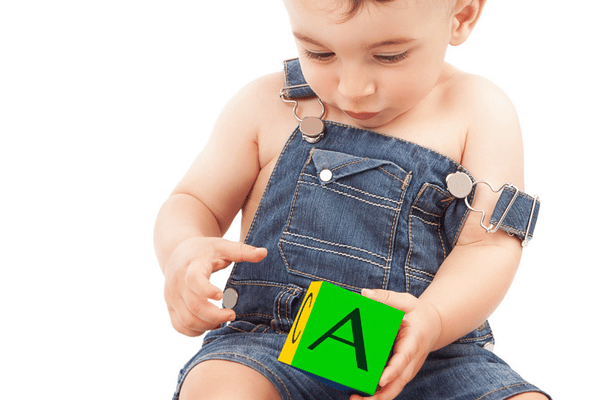
Language development is one of the most fascinating journeys in a child’s life. From birth to age five, children transform from crying newborns into chatty preschoolers who can tell stories, ask endless questions, and express complex thoughts. This remarkable process forms the foundation for all future learning and human communication.
During the early stages of life, the brain is primed to absorb linguistic patterns like a sponge. Most children follow predictable patterns as they develop speech and language skills, though each child moves at their own pace. The quality of language input they receive during these critical years shapes their ability to communicate for life.
Understanding how communication develops helps parents support their child’s growth and recognize when professional help might be needed. Speech language pathologists and other professionals use this knowledge to identify and treat language disorders early, when intervention is most effective.
This article explores the journey of language development in children, from first cries to complex conversations, and provides practical guidance for nurturing these essential skills.
The Foundation: How Children Acquire Language
Language acquisition begins before birth. Babies in the womb can hear and respond to their mother’s voice and the rhythm of their native tongue. This early exposure sets the stage for the remarkable language learning that follows.
Children acquire communication skills through a complex interplay of biological readiness and environmental exposure. The human brain comes equipped with special abilities for processing linguistic information, often called universal grammar by researchers. This innate capacity allows children worldwide to learn any communication system they hear regularly.
The National Institute of Health research shows that babies are born ready to learn human language in all its forms. Whether children raised with sign or spoken language, they follow similar developmental timelines. This flexibility demonstrates the remarkable adaptability of child development.
Communication input quality matters more than quantity alone. Children learn best through interactive exchanges rather than passive listening. When a child hears responsive conversation, their brain forms stronger connections than when exposed to background noise or television.
The early language foundation depends on several key factors. Interactions provide the context for meaningful communication. Family members who engage in back-and-forth exchanges help children understand that communication is a shared activity.
Environmental influences shape how quickly and effectively children develop communication skills. Rich linguistic environments with varied vocabulary, storytelling, and conversation support optimal growth. Children in these settings typically reach language milestones earlier and develop more sophisticated skills.
Nature versus Nurture in Communication Learning
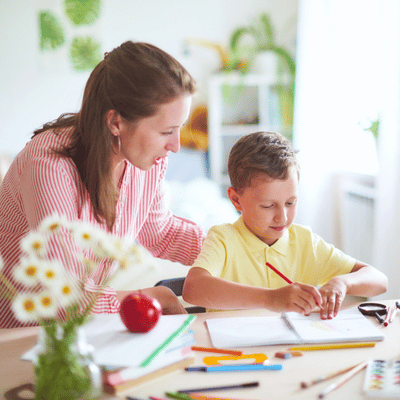
The debate between innate abilities and environmental factors continues to shape our understanding of language acquisition. Research suggests that children are born with a biological predisposition to learn language, but environmental factors determine which specific communication system they master.
Cognitive development plays a crucial role in communication learning. As children’s thinking abilities mature, they can understand increasingly complex concepts and express more sophisticated ideas. This connection between thought and communication drives continuous growth in language skills.
Interactions provide the motivation for communication use. Children naturally want to communicate with others, share experiences, and express their needs. This social drive pushes them to practice speech and language skills constantly.
The critical period hypothesis suggests that there is an optimal window for language acquisition. During the first few years of life, the brain is most flexible and receptive to linguistic input. This plasticity allows children to acquire language effortlessly when given adequate exposure.
Neuroplasticity research demonstrates that the young brain can adapt to various communication modalities. Children who lose hearing early can develop exceptional visual processing skills that support sign learning. This adaptability highlights the importance of early identification and intervention for any sensory impairments.
Birth to First Words: The Pre-Language Period
The journey of spoken language development begins with crying. Newborns use different cry patterns to communicate hunger, discomfort, or need for attention. Health professionals recognize these early vocalizations as the first attempts at human communication.
By two months, most babies begin cooing. These vowel sounds represent the first step toward speech development. Parents who respond to cooing encourage their baby to continue vocalizing, creating early conversational patterns.
Baby talk or child directed speech plays a crucial role during this period. The high-pitched, slow, exaggerated speech that parents naturally use captures infant attention and provides clear examples of speech sounds. Research confirms that babies prefer this style of communication over regular adult conversation.
Around six months, babbling emerges. Babies experiment with consonant sounds combined with vowels, producing combinations like “bababa” or “dadada.” This oral language practice helps develop the muscle coordination needed for speech.
Receptive language develops rapidly during the first year. While babies cannot speak, they understand increasingly complex communication. By twelve months, most babies recognize their name, understand simple commands, and know words for familiar objects.
The first word typically appears around the first birthday. Common choices include “mama,” “dada,” or names for favorite objects. This milestone marks the beginning of spoken language and represents a major achievement in child development.
The Importance of Early Interaction
Social interactions during the first year lay the groundwork for future communication development. When caregivers respond to baby sounds with enthusiasm and expanded communication, they teach the fundamentals of conversation.
Child directed speech naturally provides the perfect learning environment for infants. The slower pace, repetition, and emotional warmth help babies process linguistic information more easily. This specialized communication style appears across cultures, suggesting its universal importance.
Non verbal communication begins early through eye contact, facial expressions, and gestures. These prelinguistic skills support later spoken language development by establishing the social foundation for communication.
The quality of linguistic input during these early months shapes neural pathways in the brain. Rich, responsive interactions create stronger connections than passive exposure to communication through television or background conversation.
Joint attention emerges during this period when babies and caregivers focus on the same object or event together. This shared focus creates optimal conditions for word learning and establishes the social framework for future communication.
Toddler Years: Explosive Language Growth
The period from twelve to twenty-four months brings dramatic changes in communication development. Most children experience a vocab spurt around eighteen months, when word learning accelerates rapidly.
From Single Words to Simple Sentences
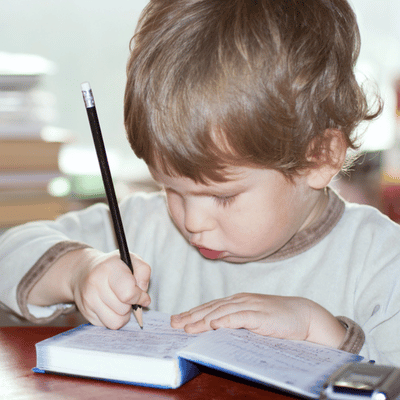
During this phase, toddlers progress from a few words to two-word combinations, marking language development. Simple sentences like “more milk” or “daddy go” demonstrate understanding of linguistic structure and early language use. These combinations show children starting to grasp grammar as development progresses and the child starts language skills.
Speech and language sounds grow clearer, though perfect pronunciation is not expected in this stage of language development. Toddlers commonly substitute easier sounds for difficult ones, saying “wabbit” for “rabbit,” a pattern a health professional reassures parents is typical. This normal speech and language growth improves with time and practice.
The vocabulary spurt marks milestone in language learning and language development in children. Children suddenly realize everything has a name and ask “What’s that?” constantly, a burst of language use fueling further language development and showing a child’s ability to learn. This curiosity drives rapid expansion of their spoken word knowledge.
Three-word phrases may emerge near the end of this period, joining the simple sentences already mastered and showing continued progress toward more complex expression. Children begin combining words in ways they have never heard, crafting new simple sentences that demonstrate their growing understanding of linguistic rules and effective language use.
The Role of Nonverbal Communication
Non verbal communication remains important during the toddler years. Children use gestures, pointing, and facial expressions to supplement growing vocabulary. These behaviors underpin language development and drive cognitive development by linking words with actions. Seeing a child hears a request and then nods shows the seamless coordination of early communication systems.
The child’s ability to understand far exceeds expression at this stage. Toddlers follow instructions, identify body parts, and answer questions about familiar objects. This gap is typical in child development, not usually a sign of language impairment, though persistent difficulty merits assessment by a health professional within ongoing cognitive development.
Sign language can supplement spoken language development. Simple gestures for “more,” “all done,” or “help” give children alternatives before full speech emerges. When a child hears and repeats these signs, cognitive development is boosted, and risk of language impairment lessens as interaction continues until language develops.
Social interactions grow more complex as toddlers learn conversational turn taking. They realise that communication demands listening as well as speaking, an insight that fuels language learning. As language development advances and language develops into longer phrases, cognitive development and child development together foster empathy and cooperation among all parties.
Understanding Individual Differences
Communication development varies significantly among children during the toddler years. Some children are early talkers who speak clearly from an early age, while others take longer to begin expressing themselves verbally.
Late talkers may have excellent understanding but limited expression. These children often catch up quickly once they begin speaking, though some may benefit from early intervention to support their development.
Temperament influences communication learning patterns. Some children are naturally more verbal and outgoing, while others prefer to observe before participating in conversations. Both patterns can be perfectly normal.
Environmental influences continue to shape development during this period. Children who receive rich linguistic input through conversation, reading, and play typically show faster progress in communication skills.
Cultural factors also influence toddler communication patterns. Some cultures encourage early verbal expression, while others value careful observation and listening. Understanding these differences helps professionals provide culturally sensitive support.
Preschool Years: Complex Communication Emerges
Between ages two and five, children learn to use complex sentences and develop sophisticated language skills. This period marks the transition from toddler speech to more adult-like communication patterns.
Grammar Development
Three-word phrases become common around age two and lengthen to full sentences by age three as language abilities grow. Children move from single words to varied verb tenses, plurals, and pronouns, making normal mistakes. This stage of language development aligns with rapid cognitive development and growing mastery of sound patterns.
Vocabulary grows dramatically in preschool. Children gain about nine new words daily, adding each spoken word to a mental dictionary soon holding thousands. Such language growth depends on talk, books, and play that spark cognitive development and provide varied language models for eager learners.
Complex grammar emerges as children experiment with sentence structures, refining language through playful trial and error. Over-generalizing rules, they say “goed” for “went,” revealing an intuitive grasp of patterns. Persistent difficulty may indicate specific language impairment, a condition where language understanding or use lags, warranting guidance from a specialist today.
Communication use becomes more sophisticated as children adjust language for different audiences. They use polite forms with adults and simpler language with younger peers, demonstrating flexible language use. Shifts in tone, vocabulary, and length show how a child hears social cues and tailors speech, strengthening relationships and preparing them for interactions in school and beyond.
Speech Sound Mastery
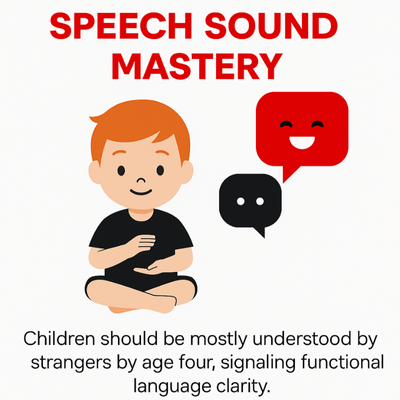
Speech sounds continue developing throughout this period as part of early language growth and broader cognitive development. Most consonant sounds are mastered by age five, though some difficult sounds like “r” may develop later. Children should be mostly understood by strangers by age four, signaling functional language clarity.
Vowel sounds are typically mastered earlier than consonants, providing the foundation for clear speech and language. Children gradually refine their pronunciation through practice, listener feedback, and playful language experiments that sharpen overall language intelligibility.
Developing language skills during preschool support later written language abilities. Children who enter school with strong oral language skills and exposure to a rich environment typically succeed more easily with reading and writing tasks.
Speech development follows predictable language patterns, with easier sounds mastered before more complex ones. Understanding these language patterns helps parents recognize normal versus concerning pronunciation issues and know when expert guidance is wise.
Narrative Skills Development
Storytelling abilities emerge during the preschool years as children learn to organize ideas sequentially. They begin recounting events from their day and creating simple fictional stories.
Complex sentences allow children to express relationships between ideas using words like “because,” “when,” and “if.” These connecting words show sophisticated understanding of logical relationships.
Conversation skills develop as children learn to stay on topic, ask relevant questions, and provide appropriate responses. These interactions demonstrate growing understanding of communication rules.
Communication use in pretend play becomes increasingly sophisticated. Children create elaborate scenarios, assign roles, and maintain character voices, showing advanced communication skills.
Metalinguistic awareness begins emerging as children start to think about their own communication. They may comment on word meanings, notice rhymes, or make jokes based on word play.
Understanding Speech versus Language
Speech and language represent related but distinct aspects of communication. Speech development refers to the physical production of sounds, while communication development encompasses the entire system of human interaction.
Speech Development
Speech involves coordinating breathing, vocal cords, tongue, and lips to produce speech sounds. Children must learn to make individual sounds clearly and combine them into words correctly. This physical skill develops gradually through practice and muscle maturation.
Consonant sounds develop in predictable sequences, with sounds like “p,” “b,” and “m” appearing before more complex sounds like “r” and “th.” Understanding these patterns helps identify normal versus delayed development.
Vowels are typically mastered earlier than consonants and provide the foundation for clear speech. Children learn to distinguish between similar sounds and produce them accurately.
Speech development depends on both motor skills and auditory processing. Children must hear sounds clearly and coordinate complex muscle movements to reproduce them accurately.
Motor planning skills become increasingly important as children attempt longer words and sentences. Some children may struggle with coordinating the rapid movements required for fluent speech production.
Language Development
Communication includes understanding meaning, combining words into sentences, and using interaction socially. Language skills encompass both receptive (understanding others) and expressive abilities (sharing thoughts and ideas).
Receptive language often develops faster than expressive abilities. Children typically understand more words and concepts than they can express, creating temporary imbalances in development.
Communication learning involves mastering multiple components including vocabulary, grammar, and pragmatics. Children must learn not just what words mean, but how to combine them appropriately.
Spoken language provides the foundation for later written language development. Children who have strong oral language skills typically transition more easily to reading and writing.
Semantic development involves learning word meanings and the relationships between concepts. Children gradually build networks of related words and understand increasingly subtle distinctions.
Identifying Communication Disorders

Communication disorders may affect speech, verbal expression, or both. A child’s speech might be unclear due to sound production difficulties, while their communication use and understanding remain strong. Alternatively, some children speak clearly but struggle with difficulties affecting vocabulary or grammar.
Speech language pathologists assess both areas to determine the nature of any difficulties. Understanding the difference helps parents recognize whether their child needs support with sound production, communication development, or both aspects of interaction.
Language disorders may be evident in difficulties with vocabulary, grammar, or interaction. Children might struggle to find words, form sentences, or use communication appropriately in social situations.
Other language disorders can affect areas like fluency (stuttering) or voice quality. These conditions require specialized assessment and treatment approaches.
Pragmatic difficulties involve challenges with social communication rules, such as taking turns in conversation, staying on topic, or understanding nonverbal cues.
The Role of Environment in Language Learning
Communication learning depends heavily on environmental factors. Kids raised in rich interaction environments typically develop stronger skills than those with limited exposure to conversation and meaningful exchanges.
Social Interaction Impact
Social interactions provide the foundation for meaningful communication development. When adults engage in back-and-forth exchanges, children learn that interaction is reciprocal and purposeful. This understanding motivates further communication attempts.
Child directed speech continues to benefit communication development throughout the early years. The simplified grammar, repetition, and emotional warmth of this communication style help children process linguistic information more easily.
Family members create the primary interaction environment for young children. The quantity and quality of conversation within the family significantly impacts child’s language development.
Conversational turns between adult and child provide crucial learning opportunities. When adults pause to let children respond and then build on their contributions, they teach the fundamentals of dialogue.
Quality Over Quantity
More language input generally leads to better outcomes, but quality matters more than quantity. Interactive conversation that follows the attention and interests proves more valuable than background chatter or passive listening.
Linguistic input that is responsive to the child’s interests and developmental level provides optimal learning conditions. When adults talk about what the child is focused on, they create meaningful connections.
Environmental influences extend beyond the home to include childcare settings, community experiences, and cultural contexts. Each environment contributes to the child’s overall communication exposure.
Responsive parenting involves recognizing and building on the child’s communication attempts. When parents expand on what their child says, they provide models for more sophisticated interaction.
Cultural and Socioeconomic Factors
Children raised in different cultural contexts may experience varying patterns of communication development. Some cultures emphasize early verbal expression, while others value listening and observation.
Socioeconomic factors can influence the quantity and quality of linguistic input children receive. However, rich interaction can occur in any family regardless of economic circumstances.
Multilingual environments provide unique opportunities and challenges for communication learning. Children in these settings may develop slightly different timelines but typically achieve competence in multiple systems.
Community resources like libraries, playgroups, and cultural centers can supplement family linguistic input and provide additional interaction opportunities.
Educational quality in childcare settings significantly impacts communication development. Programs that emphasize interaction, reading, and conversation support children’s growing skills.
Recognizing and Addressing Language Delays
Language disorders affect approximately ten percent of children, making early identification crucial. Developmental and behavioral pediatrics professionals work with families to recognize concerning signs and coordinate appropriate interventions.
Common Language Disorders
Specific language impairment represents one common type of communication disorder. Children with this condition have difficulty learning language despite normal hearing and intelligence. Early intervention can significantly improve outcomes.
Autism spectrum disorders frequently include communication difficulties as a core feature. Children may show delays in spoken language development along with differences in interactions and repetitive behaviors.
Hearing impairments can significantly impact communication development if not identified and addressed early. Even temporary hearing loss from ear infections can affect speech and language progress.
Cognitive delays may affect communication learning as part of broader developmental challenges. Children with these conditions often benefit from specialized approaches to support their interaction growth.
Warning Signs and Red Flags

Language milestones provide general guidelines for expected development, but parents should watch for specific warning signs that may indicate delays requiring professional attention.
Child starts showing concerning signs if they have no words by eighteen months, cannot combine words by age two, or remain largely unintelligible by age three. These patterns warrant professional evaluation.
Loss of previously acquired communication skills at any age requires immediate attention. Regression in speech and language abilities may indicate underlying medical or developmental issues.
Receptive language delays may be evident when children don’t respond to their name, follow simple instructions, or show understanding of common words by expected ages.
Social communication difficulties may appear as limited eye contact, lack of pointing or gesturing, or unusual patterns of interaction with others.
Persistent difficulties with speech sounds beyond expected ages may indicate motor planning or hearing issues that require professional assessment.
Professional Assessment
Speech language pathologists provide comprehensive evaluations when parents or professionals have concerns. These assessments examine both receptive and expressive language abilities to identify specific areas of difficulty.
Developmental and behavioral pediatrics specialists can assess whether communication delays are part of broader developmental concerns or represent isolated interaction difficulties.
Hearing evaluations are essential components of communication assessments, as undetected hearing loss can significantly impact speech and language development.
Cognitive assessments may be recommended to understand the relationship between communication development and overall intellectual functioning.
Standardized testing helps professionals compare a child’s skills to age-expected norms, while informal observation provides insights into functional communication use.
Professional Support and Resources
Speech language pathologists serve as primary professionals for communication development concerns. These specialists can assess child’s language development and provide targeted interventions when needed.
Healthcare Team Approach
Health professionals including pediatricians play important roles in monitoring language milestones. Regular check-ups include screening for speech and language delays and referrals to specialists when appropriate.
School aged children may receive speech and language services through educational systems. Early identification and intervention during preschool years often prevent later academic difficulties.
Developmental pediatricians specialize in evaluating children with complex developmental concerns, including language disorders. They coordinate care among multiple specialists when needed.
Audiologists assess hearing function and recommend interventions for children with hearing impairments that affect communication development.
Comprehensive Care
Cognitive development specialists may also evaluate children with communication difficulties to determine whether delays affect multiple areas or remain specific to interaction.
Other communication disorders affecting areas like hearing or motor skills may require additional professional support. Coordinated care addresses all factors influencing child’s language development.
Early intervention services provide support for children under three who show developmental delays. These programs often include speech and language therapy as a core component.
Educational support through special education services may be necessary for school aged children with persistent language disorders that affect academic performance.
Insurance coverage for therapy services varies, but many states provide early intervention at no cost to families. Understanding available resources helps families access needed support.
Supporting Language Development at Home
Parents can actively support their child’s language development through daily interactions and activities. Simple changes in communication patterns can significantly impact language skills.
Daily Interaction Strategies
Responding to child’s attempts at communication encourages further practice. When children vocalize or use gestures, parents should acknowledge and expand on these efforts to demonstrate effective interaction.
Reading together daily exposes children to new words and sentence structures beyond everyday conversation. Books provide rich linguistic input and help children understand narrative structure.
Conversation during daily routines like meals, bath time, and car rides creates natural opportunities for communication learning. These interactions feel natural and meaningful to children.
Parallel talk involves describing what the child is doing, while self-talk describes what the parent is doing. Both strategies provide rich linguistic input throughout the day.
Playful Learning
Animal sounds and other playful vocalizations capture child’s attention while teaching speech sounds. These activities make communication learning enjoyable and memorable.
Sign language can supplement spoken language development, especially for children with delays. Using gestures alongside words provides additional communication pathways and reduces frustration.
Singing and music activities support communication development through rhythm, rhyme, and repetition. These activities make linguistic patterns memorable and enjoyable.
Pretend play provides rich contexts for communication use as children create scenarios, assign roles, and engage in dialogue with toys or family members.
Screen Time Considerations
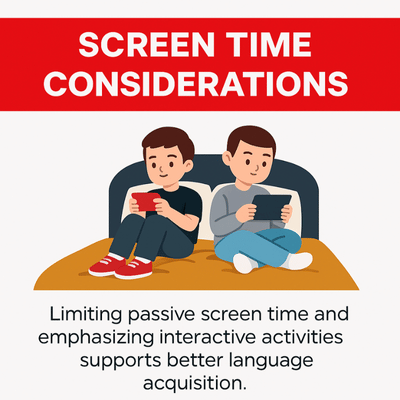
Limiting passive screen time and emphasizing interactive activities supports better language acquisition. Real-time conversation provides feedback and adjustment that recorded media cannot offer.
Educational programs that encourage interaction may have some benefits, but they should supplement rather than replace human interaction.
Co-viewing programs with children and discussing content can enhance any potential benefits from screen time.
Technology should never replace the fundamental importance of human interaction in communication learning.
Interactive video calling with distant family members can provide valuable interaction opportunities while using technology meaningfully.
Factors That Influence Language Development
Multiple factors can impact how quickly and successfully children develop language skills. Understanding these influences helps parents create optimal conditions for growth.
Biological Factors
Hearing ability is fundamental to spoken language development. Even mild hearing loss can affect speech and language progress, making regular hearing screenings important.
Cognitive development influences communication learning capacity. Children with intellectual disabilities may develop interaction skills at a slower pace but can still make meaningful progress.
Neurological development affects the brain’s ability to process and produce communication. Conditions affecting brain function can impact linguistic development in various ways.
Genetic factors contribute to individual differences in communication learning ability. Some children may have genetic predispositions to certain interaction disorders.
Birth weight and gestational age can influence developmental timelines. Premature infants may show delayed milestones initially but often catch up with appropriate support.
Environmental Factors
Family communication patterns significantly impact child’s language development. Families who engage in frequent, rich conversation typically raise children with stronger communication skills.
Socioeconomic factors can influence access to resources and opportunities that support communication development, though quality interaction matters more than economic status.
Cultural background shapes communication styles and expectations. Understanding cultural variations helps professionals provide appropriate support.
Educational opportunities including quality childcare and preschool programs can supplement family linguistic input and provide additional learning opportunities.
Neighborhood resources like libraries, museums, and community centers offer enrichment activities that support communication growth.
Individual Differences
Temperament affects how children approach communication learning. Some are naturally more verbal and outgoing, while others prefer to observe before participating.
Learning style influences how children best acquire communication skills. Some learn through imitation, others through exploration and experimentation.
Motivation to communicate varies among children. Those who are highly motivated to interact with others may develop communication skills more quickly.
Attention span affects how long children can focus on communication learning activities. Shorter attention spans may require more frequent, brief learning opportunities.
Birth order can influence communication development patterns. First children may have more adult interaction, while later children benefit from sibling models.
Language Development in Special Populations
Certain groups of children may experience unique patterns of communication development that require specialized understanding and support.
Children with Autism Spectrum Disorders
Autism spectrum disorders often involve significant challenges with social communication and interaction development. Children may show delays in spoken language or develop communication in atypical ways.
Interaction difficulties can impact communication learning since interaction develops through engagement with others. Specialized interventions focus on building social communication skills.
Repetitive language patterns like echolalia are common in autism. While these patterns may seem concerning, they can serve as building blocks for more functional communication.
Alternative communication methods including pictures, signs, or electronic devices may supplement or replace spoken language for some children with autism.
Visual supports often help children with autism understand and use communication more effectively. Pictures, schedules, and social stories provide structure and predictability.
Children with Hearing Impairments
Hearing loss significantly impacts spoken language development, but children with hearing impairments can develop strong communication skills through various approaches.
Sign language provides full access to language for children with significant hearing loss. Early exposure to sign communication supports normal developmental timelines.
Hearing aids and cochlear implants can provide access to spoken language for many children with hearing impairments. Early intervention maximizes benefits from these devices.
Bilingual approaches combining sign and spoken language can benefit children with hearing impairments, providing multiple communication pathways.
Family involvement in learning sign communication creates rich interaction environments for children with hearing loss.
Multilingual Children
Children raised in multilingual environments may show different patterns of communication development but typically achieve competence in multiple systems.
Code-switching between communication systems is normal and demonstrates sophisticated skills rather than confusion. Children learn to use each appropriately.
Balanced multilingualism occurs when children receive adequate exposure to all communication systems. Imbalanced exposure may result in stronger skills in one area.
Sequential multilingualism involves learning one system first, then adding another. This pattern may result in different developmental timelines for each communication mode.
Cultural attitudes toward multilingualism influence family decisions about maintaining multiple communication systems at home.
Looking Forward: Future Directions in Language Research
Further research continues expanding our understanding of language development in children. Scientists investigate genetic factors, brain development, and situational influences that shape language skills.
Emerging Research Areas

Studies of kids raised in bilingual environments provide insights into how the brain processes multiple communication systems. This research helps families understand normal patterns in multilingual development.
Technology offers new tools for supporting communication learning and assessing interaction disorders. Apps and devices may supplement traditional therapy approaches while maintaining the importance of human interaction.
Genetic research explores inherited factors that influence communication learning ability. Understanding genetic contributions may lead to earlier identification and intervention for interaction disorders.
Brain imaging studies reveal how communication development changes neural pathways. This research helps explain why early intervention is so effective.
Artificial intelligence applications in assessment and therapy show promise for providing personalized intervention approaches based on individual learning patterns.
Theoretical Advances
Universal grammar research explores how children worldwide develop similar communication skills despite different environments. This work helps identify core principles of human language that guide development.
The National Institute of Health continues funding research into language disorders and effective treatments. These studies improve outcomes for children with various interaction difficulties.
Social communication research examines how children learn to use interaction appropriately in different contexts. This work informs interventions for autism spectrum disorders and other conditions.
Intervention research tests new approaches to supporting communication development in children with delays. These studies help identify the most effective treatment methods.
Technology-enhanced therapy approaches are being studied for effectiveness and accessibility, particularly for families in rural or underserved areas.
Taking Action: When to Seek Help
Parents should trust their instincts when concerned about their child’s language development. Language milestones provide general guidance, but individual variation is normal within certain ranges.
Warning Signs
Child starts showing concerning signs if they have no words by eighteen months, cannot combine words by age two, or remain largely unintelligible by age three. These patterns warrant professional evaluation.
Loss of previously acquired communication skills at any age requires immediate attention. Regression in speech and language abilities may indicate underlying medical or developmental issues.
Receptive language concerns include not responding to name, difficulty following simple instructions, or lack of understanding of common words by expected ages.
Social communication difficulties may appear as limited eye contact, unusual interaction patterns, or lack of interest in communicating with others.
Persistent frustration with communication attempts may signal that a child needs additional support to express their wants and needs effectively.
Getting Professional Help
Developing language skills should progress steadily, even if slowly. Children who plateau for extended periods may benefit from professional support to restart progress.
Communication learning through intervention when natural development does not occur provides strategies and techniques that can significantly improve outcomes.
Speech language pathologists can assess whether delays are within normal limits or require intervention. They provide comprehensive evaluations and treatment plans.
Pediatricians serve as important first contacts for parents with concerns. They can conduct initial screenings and provide referrals to specialists when needed.
Early intervention programs accept referrals from parents, physicians, or other professionals and provide free evaluations for children showing developmental concerns.
Early Intervention Benefits
Early intervention services provide support when children are youngest and most responsive to treatment. The brain’s plasticity during early years makes intervention especially effective.
Family involvement in therapy maximizes benefits by extending learning opportunities throughout daily routines. Parents learn techniques to support their child’s progress.
Collaborative approaches involving multiple professionals address all aspects of child development that may impact communication skills.
Regular monitoring ensures that interventions remain appropriate as children grow and develop new needs.
Natural environment teaching integrates therapy goals into everyday activities, making learning functional and meaningful for children and families.
Supporting Diverse Learners
Every child brings unique strengths and challenges to communication development. Understanding and supporting diversity enriches our approach to fostering communication growth.
Cultural Considerations
Different cultures have varying expectations for children’s communication development. Some emphasize early verbal expression, while others value careful listening and observation before speaking.
Family communication patterns reflect cultural values and traditions. Professionals must understand these patterns to provide culturally responsive support and avoid misinterpreting normal variation as delay.
Storytelling traditions vary across cultures, with some emphasizing narrative skills early while others focus on different aspects of communication. These differences enrich our understanding of communication development pathways.
Religious and spiritual practices may influence communication patterns, including the use of formal or ceremonial expressions that children learn alongside everyday interaction.
Socioeconomic Factors
Economic circumstances can affect access to resources that support communication development, but caring interaction can occur in any environment regardless of financial status.
Community resources can help bridge gaps by providing free or low-cost access to books, programs, and activities that support communication growth.
Quality childcare and educational programs benefit all children but may be especially important for those with limited resources at home.
Technology access varies among families, but human interaction remains the most important factor in communication development across all socioeconomic levels.
Individual Learning Differences
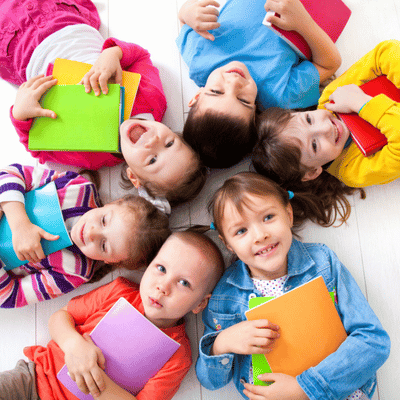
Some children are naturally quiet observers who take time to process before responding, while others are eager talkers who express thoughts immediately.
Learning styles vary among children, with some responding best to visual supports, others to auditory input, and still others to hands-on experiences.
Attention differences require individualized approaches, with some children benefiting from longer focused activities and others needing frequent brief interactions.
Motor skills development affects speech production, with some children showing clear articulation early while others need more time to develop precise movements.
Technology and Language Development
Modern families navigate an increasingly digital world, making it important to understand technology’s role in communication development.
Digital Media Considerations
Passive screen time provides limited benefits for communication learning compared to interactive human conversation. Quality matters more than the specific technology used.
Educational content designed for young children can supplement but should never replace real-world interaction with caring adults.
Video calling with distant family members can provide meaningful social interaction opportunities, especially when adults facilitate conversation.
Interactive apps that respond to children’s vocalizations may offer some benefits, but they cannot replicate the nuanced feedback that human partners provide.
Balanced Approach
Setting limits on screen time allows more opportunities for the face-to-face interaction that drives communication development most effectively.
Co-viewing programs with children and discussing content can enhance any potential benefits while maintaining human connection.
Using technology as a tool for creating content together, such as making videos or recording stories, can support communication growth through collaborative activities.
Family media plans help establish healthy technology habits that support rather than interfere with communication development.
Conclusion
Language development represents one of the most remarkable achievements of early childhood. Understanding this process helps parents support their children’s growth and recognize when professional help might be beneficial.
Most children develop communication skills naturally through everyday interactions with caring adults. Rich, responsive environments that include conversation, reading, and play provide optimal conditions for communication learning.
Early identification of language disorders allows for timely intervention when treatment is most effective. Speech language pathologists and other professionals work with families to ensure all children reach their interaction potential.
Remember that communication development is a journey unique to each child. With proper support and intervention when needed, children can develop the interaction skills necessary for school success and lifelong relationships.
Communication forms the foundation for learning, relationships, and self-expression. By understanding this process and supporting it appropriately, we give children the tools they need to thrive in our interaction-rich world.
For families concerned about their child’s progress, professional evaluation and support are readily available. Speech language pathologists and other specialists work collaboratively with families to ensure every child reaches their communication potential.
The journey of communication development continues throughout childhood and beyond. The strong foundation built during these early years supports literacy, academic success, and meaningful relationships throughout life.
Take action today by engaging in rich conversations with your child, reading together daily, and seeking professional guidance if you have concerns. Your child’s future success depends on the communication skills they develop during these crucial early years.
Every interaction matters. Whether you’re narrating daily activities, responding to your child’s babbling, or sharing a story together, you’re building the foundation for a lifetime of successful communication. Trust in your child’s natural ability to learn while providing the rich, responsive environment they need to flourish.
